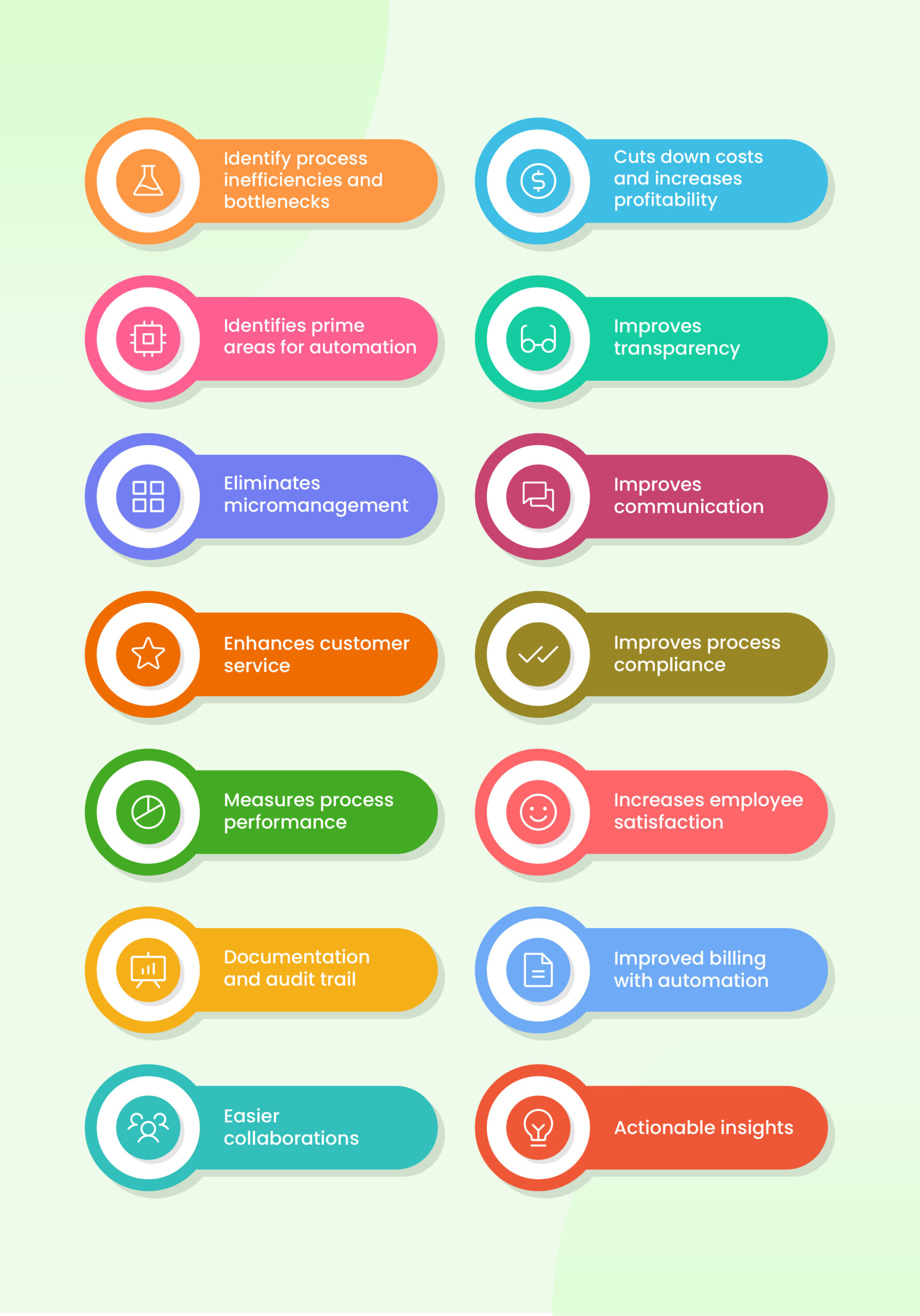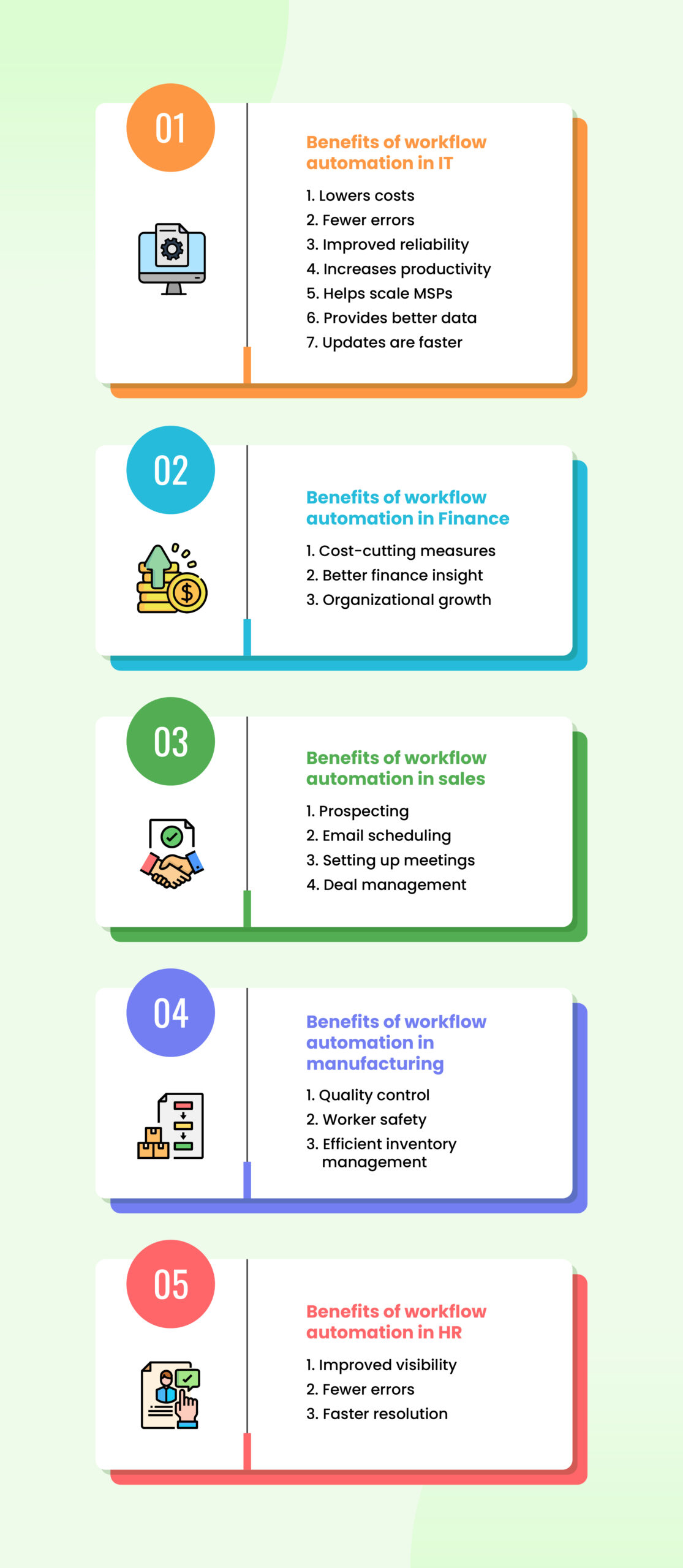To thrive in a competitive market, businesses must keep up with the growing customer expectations. Timely and regular review of operation performance is also essential for desired process outcomes — and that is not entirely possible with manual methods.
Consequently, many companies are replacing their traditional approach with workflow automation to ensure a smooth and specific order in operations to achieve the desired goals. But it does not limit the benefits of process automation to any particular industry.
From HR and IT to manufacturing and sales, workflow automation can bring many positive changes to your business outcome.
In this article, we will discuss workflow automation benefits that span various phases and different business industries.
Top business benefits of workflow automation

Identifies process inefficiencies and bottlenecks
Manual processing methods are prone to errors, biases, and bottlenecks because they depend on human effort. Delays, inefficiency, and inaccuracies become common.
Automation eliminates redundancies and streamlines operations, reducing dependency on human effort. Such an approach also brings accuracy, ensures timely completions, and brings transparency and visibility, eliminating process bottlenecks. The benefits of HR workflow automation also include a better understanding of routine activities, helping to identify inefficiencies and highlight areas of improvement.
Cuts down costs and increases profitability
Company operations usually include several repetitive steps. Handling them manually takes time and involves huge business costs. Occupying resources in a single process for long causes delays and leads to losses.
Workflow automation standardizes the process by quickly completing the repetitive steps, saving the company time and money. It also ensures optimal use of resources, improving productivity and saving business expenditure.
Identifies prime areas for automation
The foundation of HR workflow automation is process mapping, which helps identify areas where automation would have the most positive impact. For example, repetitive administrative tasks scarcely need human intervention and are ideal for implementing automation.
An HR department’s workload becomes significantly manageable to let HRs focus on the more strategic parts of their duties. For instance, data collection gets streamlined with a workflow that enables them to set up forms at crucial stages.
Improves transparency
In workflow automation, the procedures and deliverable tasks are outlined. The stakeholders, sequence, and expected outcomes are also specified. So employees know what they need to do and what to expect from each task.
Moreover, managers can track the progress through the automation software, improving visibility for all parties involved. This way, automation increases transparency and visibility into process operations by eliminating any chance of miscommunication.
Eliminates micromanagement
Micromanagement can negatively impact employee morale. Constant supervision and instructions may make your workers feel unworthy or inadequate and distract them from focusing on their work.
With automation, employee performance remains consistent with clearly predefined tasks. Both managers and concerned employees are well aware of the due date for their tasks, increasing individual accountability. This way, managers can skip following up frequently on approaching deadlines and check the status through the automation software itself.
Improves communication
Manual processing lacks transparency and has a greater chance of miscommunication. Employees, especially new hires, need clarification about whom to approach with their concerns and queries.
Process automation ensures seamless communication between the stakeholders by increasing transparency and establishing appropriate communication channels, helping every concerned individual to remain on the same page. With interactive chatbots, employees get quick resolutions to their queries. This fosters better productivity and smooth synergy with management across all departments.
Enhances customer service
Workflow automation benefits also cover customer services. Companies can use it to provide their customers with a more efficient experience. By eliminating manual processing, workflow automation helps you keep up with increasing customer requests, making it easier to scale your business.
AI technology also helps your customer service team respond quickly, bringing resolutions without subjecting customers to a long waiting period. Additionally, employees avoid the frustration that monotonous tasks entail and are more equipped to deliver satisfactory customer service.
Improves process compliance
Data regulations and compliance are getting stricter every day. But traditional processing methods demand human intervention and involve biases and errors, making standardization difficult.
But with workflow automation, companies minimize expensive human biases and can comply with the plethora of mandated regulations. This, in turn, brings better governance and control over business operations.
Measures process performance
Process automation lets you track all the tasks, key processes, parameters, and expected outcomes. You can collect the KPIs for every function and measure them for better insights on improving performance.
Increases employee satisfaction
Manual processing increases workload, overwhelming the employee and causing burnout. Automated workflow relieves employees from mundane work and lets them focus on meaningful tasks. Employees feel more engaged, and employee satisfaction increases.
Documentation and audit trail
Workflow automation eliminates lengthy paperwork, avoiding damage and misplacement of data. You can conduct accurate audit trails with smooth data storage, recording, and tracking.
Improves billing with automation
As discussed earlier, manual processes are prone to delays. But automated billing reduces staff workload, ensuring timely and accurate invoice delivery and increasing customer satisfaction.
Easier collaborations
Workflow automation gives your employees a central platform where every concerned team member can access relevant materials and documents, track progress and communicate clearly. Workflow tools make team collaboration more accessible, bringing positive business outcomes.
Actionable insights
Workflow tools offer AI-powered analytics that deciphers your collected data and produces insightful reports. Companies can use the findings to identify pain points and make informed decisions on process improvements.
Benefits of workflow automation in IT
Lowers costs
While IT system installations are expensive, a proper automation tool reduces costs by decreasing dependence on human intervention. It enables MSPs to process repetitive tasks at a higher level, delivering quality service and bringing down operational expenditure.
Fewer errors
Human effort inevitably involves mistakes, even if the professionals are IT experts. But with automation, errors in operations are unlikely. This ensures data accuracy and helps generate critically insightful reports and positive business outcomes.
Improves reliability
Error-free and efficient processing helps MSPs to deliver consistent customer service. With IT automation solutions, accuracy and in-time completion are guaranteed. This leads customers to trust the company’s services and increases its reliability.
Increases productivity
Machines do not need breaks. With workflow automation, productivity remains constant, with the system continuously processing large data sets and many repetitive administrative tasks. It also frees up the IT teams’ time and allows them to focus on the core areas of their jobs.
Helps scale MSPs
Automation efficiency allows MSPs to handle an increasing customer base without hiring more staff. Moreover, AI software can accommodate the changing requirements of a scaling business.
Provides better data
Thanks to its accuracy and reliability, automation software gathers better data. These systems create complex and deeply insightful operational reports with features like sentiment analysis.
Updates are faster
With automation software, MSPs can track every change they make to ensure they do not alter service levels.
Benefits of workflow automation in Finance
Cost-cutting measures
Cutting costs mainly falls on the finance department, causing employees to work late with bare minimum resources. But with automation taking care of the redundancy, accountants can focus on higher-value tasks such as data analytics and forecasting.
Better finance insight
Many companies lean on their finance department for valuable insight to drive strategy on financial information. Automating the operations helps them deliver finance reports with accurate insights.
Organizational growth
In the era of increasing mergers and acquisitions, reports state that 70% of these fail. A recent IMAA study reflects the integration of financial processes and reporting as the most significant challenge during an acquisition. The accuracy of automation reduces mistakes and prevents the chances of write-offs.
Benefits of workflow automation in sales
Prospecting
Automation helps the sales department to sort through hundreds of prospects and filter out the most promising leads. This way, they do not waste time manually combing through outdated leads.
Email scheduling
Emails are the most cost-effective and popular sales channels currently. With automation, the sales team can send automated cold emails and nurture leads.
Setting up meetings
Scheduling sales meetings can be tedious and time-consuming and may hamper your productivity. Automation tools can give your prospects direct access to your calendar. This way, they can schedule the meeting during any free opening without any back and forth. You can also add custom scheduling links to your email signatures for easier access.
Deal management
Workflow automation efficiently distributes deals between individual sales reps and immediately notifies them.
Benefits of workflow automation in manufacturing
Quality control
Workflow automation systems accurately check product flaws, helping manufacturers improve and reduce low-quality production.
Worker safety
Automation helps manufacturers to retain worker safety standards by using machines to perform risky work instead of humans.
Efficient inventory management
Automated inventory management can calculate the required type and quantity of raw materials for completing the product life cycle, reducing product waste and cost.
Benefits of workflow automation in HR
Improved visibility
With status-tracking features, automation tools provide enhanced visibility and reduce stress.
Fewer errors
Without manual data entry, processes have greater accuracy and consistency.
Faster resolution
Automation deals with employee requests and work items simultaneously by updating status, delivering timely information, sending alerts, and capturing requests from emails or chats.

How to get started with workflow automation?
Note your goals and objectives
Your workflow automation plan must reflect the visions and goals you have set for your business. So before implementing automation, decide what you want to achieve through this change. Goals can range from improving customer experience to saving expenses. This will help you navigate your way toward successful process automation that delivers positive business outcomes.
Identify your business needs
There can not be a specific plan that works for every business across all industries. So, to yield the benefits of process automation properly, audit all the essential elements of your business and identify bottlenecks and inefficiencies. Then, you should identify areas that could do without human intervention. This will help you make better decisions in choosing an automation platform that aligns with your business needs.
Prioritize department-wise workflow automation
Some departments in your company may need the workflow automation benefits more. Thus, decide your department-wise automation priorities based on projected ROI. This will help you maximize productivity across your company and drive higher profits.
Bring everyone on the same page
Implementing automation technology is still fresh in many industries. For successful process automation that systematically moves through every department, all your employees and leadership must be on the same page. Familiarize them with the standard regulations, the features, and the changes it would bring before a full-fledged process transformation. For more clarity, consider documenting the entire process for the workforce.
Customize the workflows
The goal of workflow automation is to make operations easier for employees. Hence, companies must find a solution that easily enables automation throughout the system. Their chosen software should also offer workflow customizations. Leena AI can swiftly accommodate growing companies without missing a beat in streamlining workflow.
Follow phase-wise implementation
Make sure the workflow automation covers every phase so there are no roadblocks between any process steps. To further streamline the process, create weekly sprints to track the progress of the implementation.
Measure and optimize
Measure how your updated strategy works and where improvements can be used to optimize the process. Ensure immediate action after identifying any weak areas.
Conclusion
Workflow automation is crucial for companies that want to prevent inefficiencies, delays, and process bottlenecks. With Leena AI’s automation solutions, businesses are seeing positive changes already.
Coca-Cola Vietnam has reportedly achieved a 40% reduction in time for approving employee requests with Leena AI’s AI-driven HR automation software.
Our platform ensures success by offering frequent employee surveys, best-in-class analytics, a secure and centralized platform, and efficient task-tracking features.
Want to change your business operations for the better? Book a demo today to explore workflow automation software!






